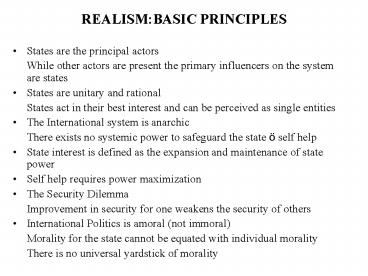REALISM:BASIC PRINCIPLES - PowerPoint PPT Presentation
1 / 11
Title:
REALISM:BASIC PRINCIPLES
Description:
International Politics is amoral (not immoral) ... Differentiates the study of international politics from the study of foreign policy ... – PowerPoint PPT presentation
Number of Views:190
Avg rating:3.0/5.0
Title: REALISM:BASIC PRINCIPLES
1
REALISMBASIC PRINCIPLES
- States are the principal actors
- While other actors are present the primary
influencers on the system are states - States are unitary and rational
- States act in their best interest and can be
perceived as single entities - The International system is anarchic
- There exists no systemic power to safeguard the
state ö self help - State interest is defined as the expansion and
maintenance of state power - Self help requires power maximization
- The Security Dilemma
- Improvement in security for one weakens the
security of others - International Politics is amoral (not immoral)
- Morality for the state cannot be equated with
individual morality - There is no universal yardstick of morality
2
Hans Morganthau (1947) Politics Among Nations
- Politics is governed by objective, knowable laws
- Key focus is on state interest as defined as
power - Forms of power may change but that states have an
interest and use power to pursue it does not - However power is defined, states will always seek
to maximize it - Prudent behavior based on rational calculations
of the consequences of actions - No universally agreed set of moral principles
thus morality can never be central point of
political behavior - Politics is different from every other sphere of
study because of its emphasis on the state and
power
3
Kenneth Waltz (1979) Theory of International
Politics
- Concentrates the study on the systemic level
Neo-Realism - Study is concentrated on how the system is
structured polarity is principal driving force - Differentiates the study of international
politics from the study of foreign policy
4
Definitions of Power
- Robert DahlPower is the ability to get someone
to do something they would not have otherwise
done - Karl Deutsch Power has
- Weight degree to which an outcome can be changed
- Scope set of issues that can be affected
- Domain what actors can be influenced
- Range difference between greatest reward and
greatest punishment
5
- Sources of Power
- Military power
- Population
- Economic Power
- Geographical Location
- Diplomatic Skill
- History and Culture
6
- Problems
- These are not absolute measures
- The concept is ambiguous
- How does one know when power has been used?
- Is the key issue material power or the more
perceptual threat? Powerful states,
particularly democratic state or close trading
partners, may pose little threat
7
Women as Proportion of US Military (FY2001)
- Recruits
- Active duty 18
- Reserve 25
- All forces
- Active duty 15
- Reserve 17
- National Guard 14
- Source Population Representation in the
Military Services, FY2001. USDOD
8
Balance of Power Equality
States or alliances approximately equal in
powerExample NATO/WTO in Cold War
9
Balance of PowerHegemony/Preponderance
One state or alliance has clear advantage in
powerExample Any hegemon (USA, UK, Rome, China)
10
Balance of PowerBalancer
one state shifts alliances so that no single
state or alliance hasguaranteed
advantageExample UK in 19th century Europe
(archetype) Tripolar USA-USSR-PRC system
1970-1990?
11
Balance of Power Collective Security
all states agree to ally against any aggressor
stateExample UN coalition against Iraq in 1991
12
(No Transcript)
13
(No Transcript)
14
(No Transcript)































